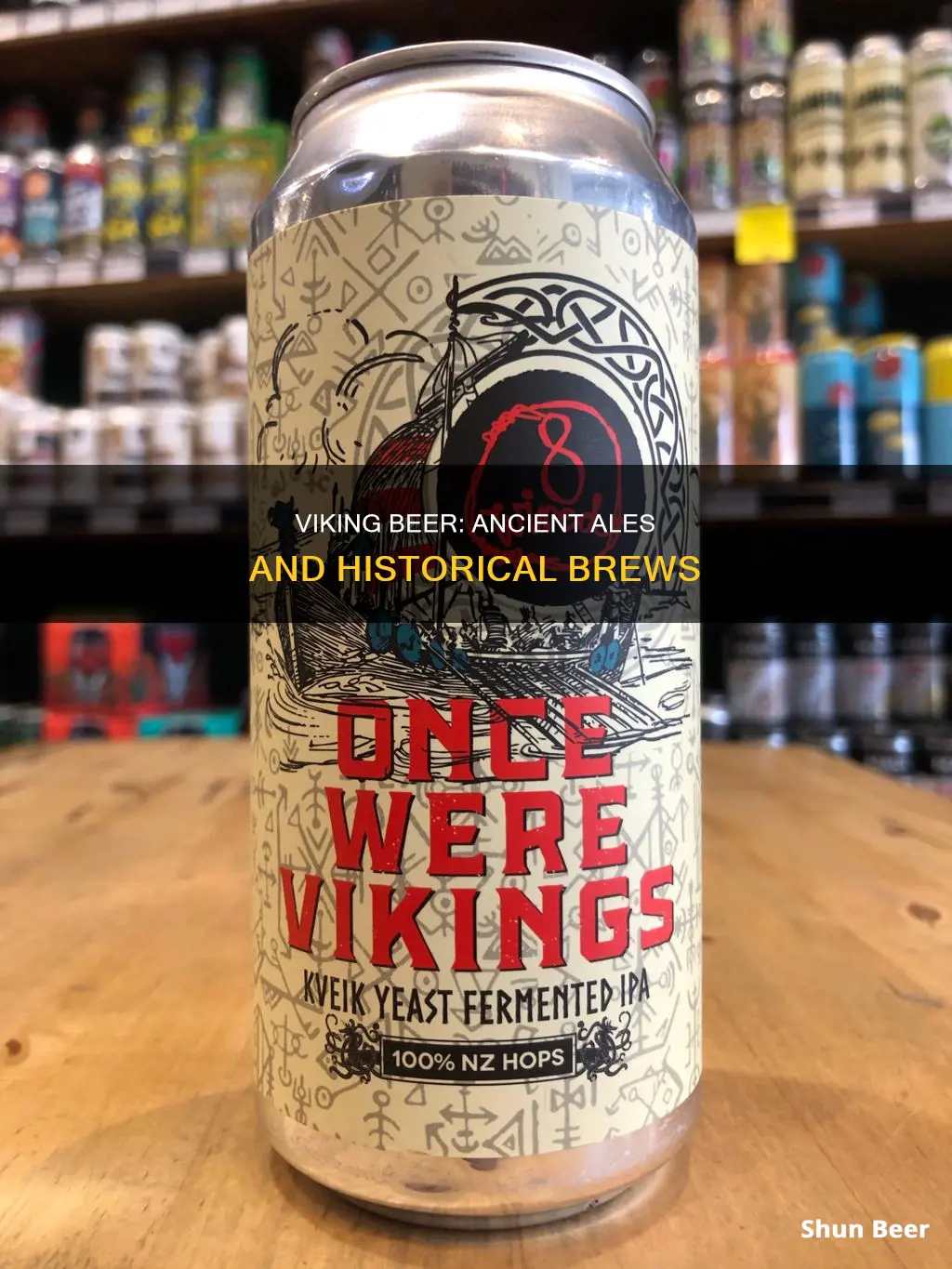
The Vikings are often depicted as fierce, long-haired warriors, but what did these legendary seafarers drink during their moments of respite? The Vikings drank beer (ale), mead, and occasionally wine. Mead was likely the first alcoholic drink in Viking culture, with beer following later. Both drinks were integral to Viking culture and society.
| Characteristics | Values |
|---|---|
| Main ingredients | Barley, water, yeast |
| Other ingredients | Oats, rye, hops, juniper, herbs and spices |
| Flavouring | Gruit (yarrow, sweet gale, wild rosemary) |
| Alcohol content | 2-4% ABV |
| Occasions | Daily, celebrations, rituals |
| Container | Drinking horns |
What You'll Learn

Vikings drank ale, not beer
While the Vikings did consume alcoholic beverages, the drinks they consumed were more akin to what we would now call ale rather than beer. This is because the distinction between ale and beer lies in the ingredients and brewing process. Ale, like the drink consumed by the Vikings, is traditionally brewed using malted barley, water, and yeast, and flavoured with herbs and botanicals such as gruit, a mixture of herbs including yarrow, sweet gale (bog myrtle), and wild rosemary. Beer, on the other hand, typically uses hops as a key flavouring and preserving agent, which also imparts bitterness to the drink. The use of hops in brewing only became widespread in Europe around the 12th and 13th centuries, after the Viking Age had ended.
The Vikings' ale was consumed by people of all ages and social classes and played a central role in their feasts, celebrations, and rituals. It was also a perfect beverage to bring on long sea journeys, as the raiding warriors (Vikings) were prone to do. Ale, like beer, is fermented, allowing a longer shelf life, which in turn allowed raiders to embark on longer expeditions without having to stop for fresh water. The fermentation process also resulted in a higher calorie count, making it a good source of energy.
The brewing process for Viking ale began with the selection of ingredients, which mainly included barley, water, and yeast. Other grains, such as oats or rye, were occasionally used, but barley was the most common choice as it was widely grown in Scandinavia. The barley was first soaked in water and allowed to germinate, a process known as malting. Once malted, the barley was dried and ground into a coarse flour called "grist." The grist was then mixed with hot water, creating a thick, porridge-like mixture called "mash." The heat and enzymes in the malted barley broke down the starches into fermentable sugars. The resulting liquid, known as "wort," was then drained from the mash and boiled with various herbs or spices, which served as both flavourings and preservatives. After cooling the wort, yeast was added to initiate the fermentation process, with the yeast consuming the sugars and producing alcohol and carbon dioxide, thus transforming the wort into ale. The ale was then transferred to wooden barrels or other vessels for aging before being consumed.
The alcohol content of Viking ale was relatively low, usually ranging between 2% and 4% ABV (alcohol by volume). This made it suitable for daily consumption and as a source of hydration. In comparison, most contemporary beers have an alcohol content between 4% and 6% ABV, with some styles exceeding 10%. The Vikings also drank strong beer at festive occasions, alongside the popular drink of mead, a sweet, fermented drink made from honey, water, and spices.
Sportsbook Beer: BYOB or Casino Rules?
You may want to see also

Ale was made from spruced and malted barley
Ale was an essential drink in Viking society, consumed by all ages and social classes. It was a staple at feasts, celebrations, and religious rituals, and it was also drunk after meals. The brewing was typically done by women, who were highly respected in Norse society and in charge of everything inside the home.
The Viking ale, or "öl", was made from spruced and malted barley. The process began with sprucing or sprouting the barley grains by introducing moisture, which produced sprouts. The sprouts, unlike the grain, contain sugar, not just starch, and can be fermented with yeast. The sprouts were then dried, and this substance is called malt. The malt was then ground, mixed with water, and heated to further break down the starches into fermentable sugars. This created a soupy, yeasty solution called "wort".
At this point, the Vikings added either hops or gruit, a mixture of herbs, to the wort. Gruit was made from sweet gale (Myrica gale), mugwort, yarrow, ground ivy, horehound, and heather, among other possible herbs and spices. The addition of juniper and other herbs would have had minor antibacterial properties, extending the time the ale could be stored. The yeast used to make the ale was cultivated and passed down from one batch to the next.
The resulting brew was syrupy, mostly unfiltered, and unpasteurised, with a yeasty taste that was countered by the flavour of juniper berries and herbs. It was likely only weakly alcoholic but had a high caloric content, providing nourishment and energy. The ale was also not carbonated, as the process to do so was not yet invented, and it was served at whatever temperature the Vikings could achieve, sometimes even hot in the form of ale-soup.
Tongue Piercing and Beer: What You Should Know
You may want to see also

Ale was flavoured with herbs and botanicals
Ale was an essential drink in Viking society, consumed by people of all ages and social classes. It was a source of nourishment and an integral part of social gatherings and religious rituals. The Vikings' ale was flavoured with herbs and botanicals, such as the gruit mixture, which included sweet gale (bog myrtle), wild rosemary, and yarrow. These herbs not only added distinct flavours to the ale but also served as natural preservatives, extending its shelf life.
The gruit mixture was likely not the only herbal combination used by the Vikings to flavour their ale. They also probably used other common herbs and weeds, as they would not have wanted to waste precious spices on a common drink. The addition of juniper, for example, would have contributed to the flavour and provided minor anti-bacterial properties, further extending the ale's storage time.
The yeast used to make the ale was cultivated and passed down from one batch to the next. The resulting brew was syrupy, mostly unfiltered, and unpasteurised, with a yeasty taste that was countered by the herbs and botanicals added to it. While hops may have been used, they were not the primary flavouring agent as they are in beers today.
The Vikings' ale was quite different from the beers we are familiar with today. It was cloudy and somewhat viscous, with a relatively low alcohol content, usually ranging from 2% to 4% ABV. The taste likely varied depending on the specific recipe and ingredients used, but it generally had a sweet, malty base with herbal and spicy undertones from the gruit mixture.
The process of brewing ale was an important part of Viking culture, with each household brewing its unique blend. The brewing began with malting the barley, followed by mashing, boiling, and fermenting. The final product was then aged in wooden barrels or other vessels before consumption.
The ale played a central role in the Vikings' feasts, celebrations, and rituals. It was consumed after meals and during festive occasions, alongside the popular drink of mead. The Vikings also drank ale before battles, as a means to boost courage and numb the senses.
Beer and Keto: Can You Enjoy a Weekly Brew?
You may want to see also

Ale was drunk by all ages and classes
Ale was drunk by all ages and social classes in Viking society. It was a staple drink, consumed by both men and women, young and old. It was not only a source of nourishment but also played a central role in social gatherings and religious rituals.
Ale was typically brewed in households, with women being responsible for the brewing process. Each family had its own unique recipe, resulting in a variety of flavours and characteristics. The brewing process began with malting the barley, drying it, and grinding it into a coarse flour called "grist". The grist was then mixed with hot water to create a thick, porridge-like mixture called "mash". The starches in the mixture were broken down into fermentable sugars by heat and enzymes. The resulting liquid, known as wort, was then drained from the mash and boiled with herbs or spices, which served as flavourings and preservatives. Finally, the wort was cooled, yeast was added, and the mixture was left to ferment. The ale was then transferred to wooden barrels or other vessels for aging before being consumed.
The taste of Viking ale likely varied depending on the specific recipe and ingredients used, but it generally had a sweet, malty base with herbal and spicy undertones. The alcohol content was relatively low, usually ranging from 2% to 4% ABV, making it suitable for daily consumption and hydration.
The consumption of ale was an important part of Viking culture and society. It was seen as a symbol of camaraderie and a means to forge bonds among community members. It was consumed after meals and during feasts and celebrations, and it was also believed to have mystical properties and was associated with the gods. The drinking of ale is portrayed in Viking mythology, such as in the story of the heavenly goat Heidrun, which produces ale/beer/mead instead of milk.
Beer Drinking: How Much is Too Much?
You may want to see also

Mead was reserved for special occasions
The Vikings drank both beer and mead, but mead was reserved for special occasions. Mead was a sweet, fermented drink made from honey, water, and spices. It was believed to have mystical properties and was associated with the gods, particularly Odin, the chief deity in Norse mythology. Mead was also an essential element in the Viking tradition of the "sumbel", a ceremonial drinking ritual that involved toasting the gods, ancestors, and heroes. During a sumbel, participants would drink mead from a shared horn while reciting poetry, boasting of their accomplishments, and making solemn vows.
The Scandinavians started drinking mead before they drank beer, and it was mostly used on special occasions. Mead was made from honey, which was a valuable and scarce commodity. The process of making mead involved mixing three pounds of honey with a gallon of water.
While mead was reserved for special occasions, beer was consumed regularly by the Vikings. Both weak and strong beer was produced, with the weak beer being suitable for children as well as adults. Beer was made from fermented grains of barley, which were pressed and boiled in water in a kiln. The weak beer could be consumed after eating salty Viking food to quench thirst. Strong beer was consumed during festive occasions, along with mead.
In addition to mead and beer, the Vikings also drank ale, which was the most common alcoholic beverage in their society. Ale was made from malted barley, water, and yeast, and flavored with herbs and botanicals such as the gruit mixture, which included yarrow, sweet gale (bog myrtle), and wild rosemary. Ale was consumed by all classes and ages and was an integral part of social gatherings and religious rituals.
Ice Fishing and Beer: What You Need to Know
You may want to see also
Frequently asked questions
Vikings drank water, beer, mead, and occasionally wine.
Mead is a sweet, fermented drink made from honey, water, and spices.
Viking beer, or ale, was made from spruced and malted barley. It was flavoured with juniper berries and herbs, including hops, and filtered through a mesh of branches.
Yes, drinking was an integral part of Viking society and culture. It was a staple at feasts, celebrations, and religious rituals.







